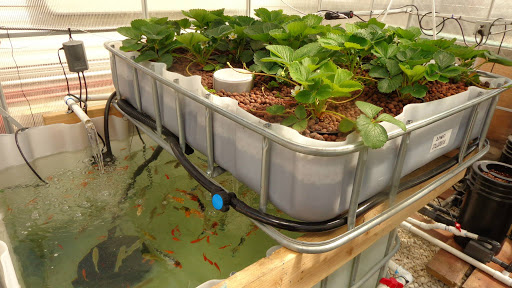Master Aquaponics with Our DIY Beginner Guide
Hey there, future aquaponics guru! So you're thinking about diving into the fascinating world of aquaponics? Awesome! It's a rewarding journey, combining fish farming (aquaculture) with hydroponics (soilless plant growing) in a symbiotic, sustainable system. Sounds complicated? Trust me, it's way easier than you think, especially with this beginner's guide. We'll break it down step-by-step, making this DIY project manageable and fun.
Understanding the Aquaponic Cycle: It's All About Symbiosis!
At its heart, aquaponics is all about teamwork between fish and plants. The fish happily swim around, producing waste (poop, essentially). This waste, believe it or not, is plant food! Beneficial bacteria break down the fish waste into nitrates, which are then readily absorbed by the plants' roots. The plants, in turn, filter the water, keeping it clean and healthy for the fish. It's a beautiful, self-sustaining circle!
The Key Players:
- Fish: Your choice of fish depends on your system's size and your climate. Popular beginner choices include tilapia (hardy and fast-growing), goldfish (tolerant of slightly less-than-perfect conditions), and koi (for larger systems).
- Beneficial Bacteria: These tiny heroes are the unsung champions of the aquaponic system. They live in the grow bed and convert fish waste into plant-usable nutrients. Don't worry; you don't need to add them specifically – they'll naturally colonize your system over time.
- Plants: Choose plants that are relatively fast-growing and tolerant of fluctuating nutrient levels. Leafy greens like lettuce, herbs like basil and mint, and even some fruiting plants like strawberries, are great starting points.
Building Your DIY Aquaponic System: A Step-by-Step Guide
Let's build something amazing! We'll focus on a simple media bed system – perfect for beginners. This system uses a container for the fish tank and a separate container filled with gravel or clay pebbles for the plants.
1. Gathering Your Materials:
- Fish tank: A large plastic storage tub, a repurposed aquarium, or even a modified IBC tote will work. Choose something durable and non-toxic.
- Grow bed: Another plastic storage tub or similar container. The size should be proportional to your fish tank – a larger grow bed provides more growing space but also requires a more robust water pump.
- Grow media: Clay pebbles (hydroton), gravel, or lava rock are all excellent choices. Make sure it's thoroughly rinsed before use.
- Water pump: A submersible pump is essential to circulate water from the fish tank to the grow bed and back. Choose one that's appropriate for the size of your system.
- Air pump (optional but recommended): Adds oxygen to the fish tank, promoting healthier fish.
- Plumbing: Flexible tubing to connect the pump to the fish tank and grow bed.
- Plants and fish: Start small! A few plants and a small number of fish allow you to learn and adjust before scaling up.
2. Assembling Your System:
- Set up the fish tank: Place it in a location with access to sunlight (for the plants) but out of direct sunlight (to prevent algae blooms).
- Prepare the grow bed: Fill it with your chosen grow media.
- Connect the pump: Submerge the pump in the fish tank and run the tubing to the grow bed, ensuring a gentle flow. The water should drain back from the grow bed to the fish tank by gravity.
- Plant your seedlings: Gently place your seedlings into the grow media, ensuring their roots have good contact.
- Add your fish: Introduce your fish gradually, allowing them to acclimate to the water temperature and environment.
3. Monitoring and Maintenance:
Regular monitoring is crucial for a healthy aquaponic system. Check your water parameters regularly (pH, ammonia, nitrite, nitrate), adjust water levels as needed, and remove any dead plants or debris.
Troubleshooting Common Aquaponics Issues
Don't worry if things don't go perfectly smooth the first time. Aquaponics, like any other system, presents some challenges along the way.
Algae Blooms:
Too much sunlight can lead to excessive algae growth. Try shading your system or reducing the sunlight exposure.
Fish Disease:
Maintaining good water quality is essential to prevent fish diseases. Regular water changes and proper filtration are key.
Nutrient Deficiencies:
If your plants aren't thriving, they might be lacking essential nutrients. You can use a water testing kit to assess nutrient levels and adjust accordingly.
Frequently Asked Questions
Here are some answers to commonly asked questions by new aquaponics enthusiasts.
Q: How much does a DIY aquaponics system cost?The cost varies depending on the size and complexity of your system, but you can build a basic system for a few hundred dollars using recycled materials.
Q: How often do I need to change the water?You usually don't need to do large water changes in a properly balanced aquaponics system. Small top-offs to compensate for evaporation are usually sufficient. Larger water changes may be needed occasionally if the system gets out of balance.
Q: What if my plants aren't growing well?Several factors can affect plant growth, including nutrient levels, light exposure, water temperature, and the overall health of the system. Regularly monitoring the system and testing the water will help you diagnose and address any problems.
Q: How much time does it take to maintain an aquaponics system?The time commitment depends on the size of your system. A small system might require only 15-30 minutes of maintenance per week, while larger systems require more attention.
Q: Can I build an outdoor aquaponics system?Absolutely! Outdoor systems are very common, but you'll need to consider factors like weather, sunlight, and protecting your fish from predators.
There you have it! A complete beginner's guide to building your own aquaponics system. It may seem like a lot at first, but remember to start small, learn as you go, and enjoy the process! Happy growing!






